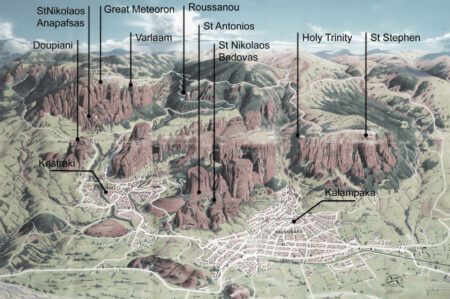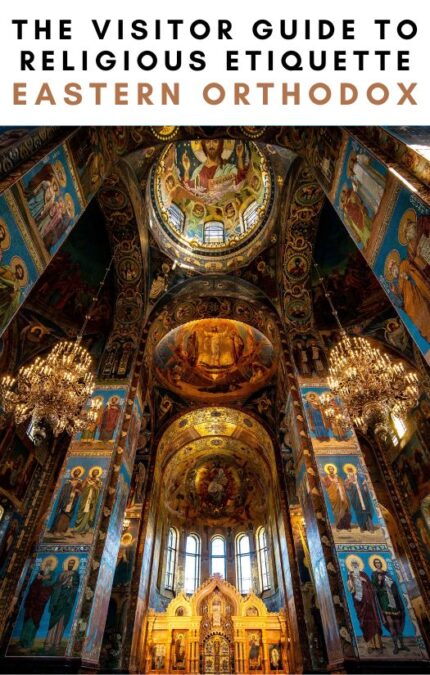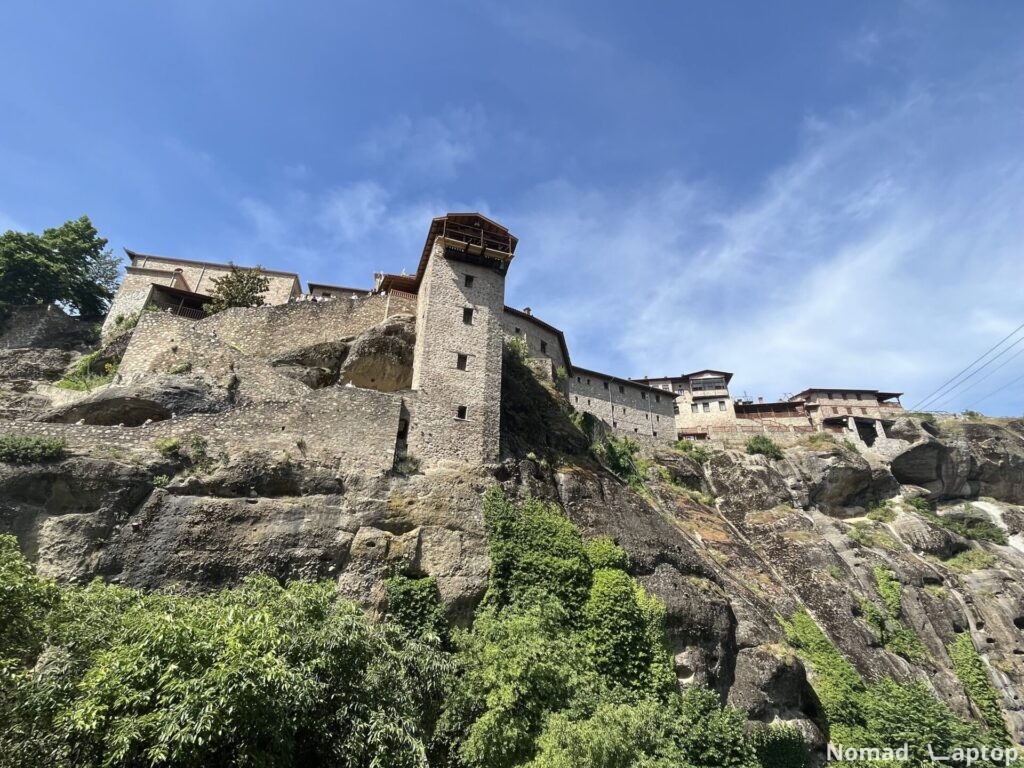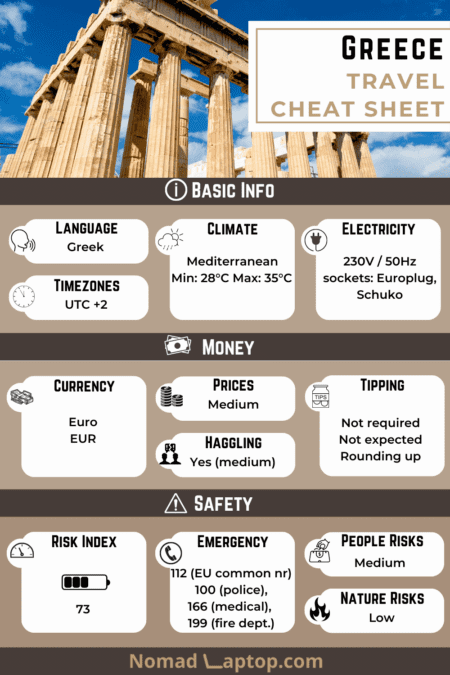- Contents
- Meteora
- What to expect
- Tips & Impressions
- The region
- The monasteries
- Opening hours
- Prices
- Best time to visit
- Country Info
- Safety
- Getting around
- Weather
- Etiquette
- Offers
- Visit Overview
- Monastery of St. Nicholas Anapausas
- Nunnery of Rousanou
- Monastery of Varlaam
- Monastery of the Great Metereon
- Monastery of the Holy Trinity
- Nunnery of St. Stefanos
- Closing thoughts
Meteora is one of the most inspiring and mystical sites in Greece and the second most visited place in the country, after the unchallenged Acropolis of Athens.
Situated in the Thessaly region of central Greece, this remarkable place consists of numerous natural sandstone rock formations that rise about 400 meters from ground level.
The Meteora monoliths are a sight in themselves, but if that wasn’t enough, around the 14th century several Greek Orthodox monasteries were built on the top plateaus, and each monastery looks like a crown placed on top of the rock formation.
For centuries, the monks resided in these monasteries despite the difficult environment and rugged terrain. It is now a UNESCO World Heritage Site, regarded as a valuable historical and cultural monument. Meteora is an incredible example of a unique landscape filled with towering spires, shrouded by clouds or fog almost daily. Exploring Meteora is an unforgettable experience and offers travelers stunning views of the surrounding countryside.

What to expect
- Otherworldly smooth black monoliths tower towards the sky.
- The isolation-defining monasteries perched on top of the monolith plateaus look like they were carved from the stone itself.
- The towns of Kalabaka and Kastraki offer the classic, wonderful characteristics of Greek mainland towns. Cafes serving refreshing freddo coffees, excellent cuisine, byzantine churches, and a slower pace of life are certainly refreshing.
Tips & Impressions
- If you’re planning a visit to Meteora, basically everywhere you will see recommendations to spend at least 2 days seeing all six monasteries. I agree with this, as visiting all monasteries in a day is not only exhausting but also diminishes the impact while giving less time to visit each one.
- That being said, visiting all of them in a day is doable as they are all close to each other and easily reachable by car up to the steps leading to the entrance. On top of this, the monasteries are all relatively small, and without going into a deep guided visit, it can be done in less than an hour.
- In my opinion, the “best” monasteries to visit are the unskippable Grand Meteoron and Varlaam, the two largest ones. The monastery of the Holy Trinity is the most famous and photographed one. The smallest one of Saint Nicholas is wonderful as it attracts fewer visitors. Finally, the two nunneries of Rosanou and Saint Stephens.
The region

The name meteora is related to meteōros, which means “elevated” or “high/suspended in the air”, and is related to the meteor celestial objects. The word is perfect for these rock formations, as seeing them is akin to gazing at something otherworldly and can really inspire a sense of looking at a lunar landscape.
The imposing, vertical, and smooth rocks were formed 60 million years ago from movement in the Earth’s crust, and the constant weathering through millions of years smoothed them out into dark, curved monoliths.
The area around Meteora has been inhabited since antiquity, and the Theopetra Cave (as of today, permanently closed to visitors for safety reasons) is considered to be the oldest cave with human presence in the world, dating back 50,000 years.
At the base of the rock formations are two small towns, entirely geared towards tourism. The main city of Kalambaka (or Kalampaka or Kalabaka), and the small and more tranquil town of Kastraki at the base of the road winding through the rock formations.
The monasteries
Meteora is the most important monastic community in Orthodox Christianity, second only to that of Mount Athos.
The history of the Meteora monasteries starts between the 9th and 10th centuries when hermit Orthodox Christian monks isolated themselves in the caves of the Meteora cliffs.
For several centuries, monastic life remained in this unorganized manner until the 12th century, when a monk by the name of Nilos created the first basis of a community. The scattered monks were gathered, and the first set of rules and cannons were established.

It was not until the 14th century that the monk named Athanasios the Meteorite established the first monastery on the second-highest and most imposing of the Meteora rocks. Being the founder of this highly important monastic community, Athanasios is one of the most important figures in Orthodox Christianity.
After the founding of the first monastery, many monasteries were built around Meteora, up to a total of 24 during the following 300 years. From the 17th century on, the decline of the monastic community started to quickly decline, until this day, when only six active monasteries remain.
Prices
Each monastery requires a ticket for 3 euros to be purchased at the entrance.
Opening hours
Each monastery has specific opening hours and is closed on certain days, as well as having timetables based on season, as can be seen below
Summer season (April–October)
| Monastery | Opening hours | Closed on |
| Agios Nikolaos | 9:00 – 17:00 | – |
| Varlaam | 9:00 – 16:00 | Friday |
| Roussanou | 10:00 – 15:00 | Wednesday |
| Great Meteoron | 9:30 – 15:00 | Tuesday |
| Holy Trinity | 10:00 – 16:00 | Thursday |
| Agios Stefanos | 9:30 – 13:30, 15:30 – 17:00 | Monday |
Winter season (November–March), basically the same opening hours as summer but 1 hour before closure
| Monastery | Opening hours | Closed on |
| Agios Nikolaos | 9:00 – 16:00 | Friday |
| Varlaam | 9:00 – 15:00 | Thursday, Friday |
| Roussanou | 10:00 – 14:00 | Wednesday |
| Great Meteoron | 9:30 – 14:00 | Tuesday, Thursday |
| Holy Trinity | 10:00 – 15:00 | Wednesday, Thursday |
| Agios Stefanos | 9:30 – 13:00, 15:00 – 17:00 | Monday |
Country Info
- Language: Greek is the official language.
- Population: 1.1 million (2019 est.)
- Ethnic Groups: Greek 98%, other 2%
- Religions: Greek Orthodox 98%, Muslim 1.3%, other 0.7%
- Political System: parliamentary republic; monarchy rejected by referendum 8 December 1974
- Currency: Euro (EUR).
- Credit Cards: Cards are widely accepted and ATMs are widely distributed. Payment preference though is cash
- Electricity: socket types: Europlug, Schuko, 230 volt / 50 hertz
Check the Greece page for more country general information
Safety
- Safety: There aren’t any risks in Meteora. At worst, a sprained ankle from a misstep Given the conformation of the area, with the towering rocks standing 300–400 meters over the valley beneath, fear of heights might be an issue.
- Emergencies number: 112 (common EU number), 100 (police), 166 (medical), 199 (fire dept).
Getting around
- Hiking: walking to the monasteries is doable and there are nice hiking trails but it is an arduous climb depending on how many monasteries you wish to visit. After all the trail is intended to be a pilgrimage in itself. It is best to find accommodation in the town of Kastraki rather than the larger Kalambaka since the former is right beneath the meteoras.
- By car: Driving to and around Meteora is easy with a car. There is a single well-paved winding road with several small lookout points on the side of the road where one can stop and take in the beautiful view.
- Within monasteries: there isn’t a particular route to follow and in general, the monasteries are small. Almost all require a small climb up stairs to reach the complex. Clearly, everywhere there is the church interior, often a courtyard and a library and museum holding ancient relics, books, and icons used during the 14th century.
Check the Driving in Greece page for more driving tips and information
Weather
Meteora is not at a high elevation (330m) so don’t expect a mountainous climate. The weather is akin to the rest of mainland Greece, namely the Mediterranean continental. This means there are hot summers and cold winters.
It is common year-round for clouds to be present in the area.
Etiquette
- Despite the monasteries not being used anymore by the monks, they are still religious sites with consecrated churches. As such it is important to dress appropriately. Because they are Orthodox monasteries, there is a stricter dress code when compared for example to Roman Catholic churches. Men should wear long pants and sleeved shirts. Women should wear long skirts entirely covering their legs and in some monasteries a head scarf. Both of these are handed out and can be found at the various ticket entrances.
- Eastern Orthodox religion does not allow photos of the interiors of churches. Because of the more mystical approach to religion, the katholikons (the chapels) are quiet, incense-filled small enclosures with candlelights and surrounded by paintings of saints, inexpressive and without perspective in the art. This is to indicate that the visitor/pilgrim is an integral part of the environment and in some ways is the one who applies the depth and third dimension to the surroundings. Because of this, visiting an Orthodox church is a communion experience with the divine and not a detached visit. As such photography is strictly forbidden

For more information on Greek Orthodox religion and visitor etiquette check out this article

Trivia pill
90% of the population is Christian Orthodox. Orthodox Christianity is the third largest denomination of Christianity and has ancient roots dating back to the early years of the religion. The church split from the Roman Catholic Patriarch during the “Great Schism”.
Easter for example is celebrated similarly as a great mourning for the death of Christ but is followed by big festivities to celebrate the resurrection and is seen as a great victory and ascension over earthly shackles.
The religion has more mystical aspects to it and, being orthodox, a more strict interpretation of the original dogmas and creeds.
Offers
Visit Overview
Monastery of St. Nicholas Anapausas
Agiou Nikolaou Anapausa – Αγίου Νικολάου Αναπαυσά

About
The Holy Monastery of Saint Nicholas of Anapafsas is the first that can be encountered from the town of Kastraki. It is the smallest and was used as a resting stop for the pilgrims (anapafseos meaning “resting”). It is a tall rectangular building with successive levels and has no courtyard, a small church of St. Anthony, and the chapel of St. John Prodromos.
Impressions
The first monastery I visited was the “resting” stop of the monastery of Saint Nicholas. It was relatively early in the morning and the monastery is one of the least visited and also the smallest. Because of this, it was empty except for me, and a couple of priests, one checking the entrance tickets and another one sleeping inside the chapel. The peaceful interiors and quiet view of the surroundings on the top of the monastery made it one of my favorites, despite it being incredibly small and with quite a hard climb as there is a steep hill to just reach the base of the meteora, followed by a short set of steps.
Nunnery of Rousanou
Rousanou – Ρουσάνου

About
The second which will be found is the Monastery of St. Barbara or Roussanou. It is the lowest one of the 6 monasteries but impressive as it uses all available space of the plateau on top of the rock making it seem like it was carved out of stone. The monastery is a three-story structure and is dedicated to the Transfiguration of Jesus Christ with the Katholikon built in 1545. Since 1980 the monastery has been used as a nunnery.
Impressions
The nunnery of Rousanou is one of the two nunneries in Meteora, the other being Saint Stefanos. Personally, I found it to be better from the outside with respect to Saint Stefanos, and contrarily worse on the inside.
Monastery of Varlaam
Varlaam – Βαρλαάμ

About
The Holy Monastery of Varlaam is the second largest monastery and is located nearby the larger Grand Meteoron. It owes its name to the hermit Varlaam, who first inhabited the rock in the 14th century. In 1518 the chapel was heavily modified and renewed and dedicated to the Three Hierarchs of Eastern Orthodox Christianity (Basil the Great, Gregory the Theologian, and John Chrysostom).
Impressions
In my opinion, this is the most beautiful of the six monasteries. It is located between all other monasteries and can be seen from all others and is wonderful from each angle. It has an ample courtyard that offers great views of the surroundings. The inner church is the one that impressed me the most (and where I snuck in a quick photo, although strictly forbidden and also disrespectful).
Monastery of the Great Metereon
Metamorfossis/Megalo Meteoro – Μεγάλο Μετέωρο

About
The Holy Monastery of Great Meteoron (or Megalo Meteoron) is the largest and oldest and as stated above, the founding of this monastery in 1350 kickstarted the building of other monasteries in the region.
It is also known as the Holy Monastery of the Metamorfossis (Transfiguration of Christ) and is a male monastery.
From a visitor’s perspective, the Great Meteoron is the most comprehensive visit as it includes the main museum. Also, the sacristy is interesting as it contains skulls of the monks who have lived in the monastery over the years.
Impressions
This is the main monastery which is a must-see on any kind of visit whether hiking, by car, or on a tour bus. The church is incredible with many detailed frescoes and there is also a museum hosting impressive ancient high-value religious relics and icons, as well as a gallery depicting some historical recounts of bombings and battles that occurred in WWII.
Monastery of the Holy Trinity
Agias Triados – Αγίας Τριάδος

The Monastery of Holy Trinity (or Agia Triada) is the most iconic in terms of photography as it is perched on top of an isolated pillar, exemplifying the architecture of the monasteries of Meteora.
Arguably the most famous it was also featured in the 007 movie “For Your Eyes Only”. It suffered a lot of damage during the World War and was rebuilt. It is arguably the most difficult one to reach as it requires following a path downhill to the foot of the cliff and then up the 145 spiraling steps into the monastery.
The monastery is dedicated to the Holy Trinity and was built in 1488 by the monk Dometios. Inside is the chapel of St. John the Baptist, the catholicon, and a large terrace on the highest point of the rock which offers a wide view of all the other monasteries.
Impressions
This was the last monastery I saw on the first day. I was already quite exhausted and Agia Triada is the hardest to “climb”. The view from the terrace however was amazing.
Nunnery of St. Stefanos
Agios Stefanos – Αγίου Στεφάνου

About
Very close to Agia Triada is the Monastery of Saint Stephen. It is the first to be encountered if coming from the city of Kalabaka. This is the easiest of the 6 to reach as it doesn’t involve steps and is rather accessed by crossing a small bridge.
It was founded by the monk Antonios Kantakouzenos and became Stauropegic (independent from the local bishop) in 1545. This monastery was also severely damaged during WWII. The main cathedral is dedicated to Saint Charalambos and this monastery, like Rousanou, was also converted into a nunnery in the mid 1900.
Closing thoughts
Visiting Meteora is a breathtaking experience in any form. The first time I visited I was a kid, almost 30 years ago, and it has always remained etched in my memory as an otherworldly, lunar landscape and inspiring place.
It is the second most visited place in Greece, after the unchallenged Acropolis of Athens. Personally, I find them awe-inspiring and completely unique. Without taking anything away from the Parthenon, the greatest temple in existence, and criminally not listed in the “new 7 wonders of the world”, it is “just” another temple. Meteora instead is unique, one-of-a-kind, and inspiring in all ways, from the natural aspect to the religious devotion and art of the monasteries, to the natural beauty of the valley that surrounds it.
The small tourist town of Kalabaka or the smaller village of Kastaki at the foot of the rock formations are a wonderful place to spend some time, enjoying the views and calm and serene atmosphere while eating delicious Greek cuisine. Traveling upwards through the winding road within the Meteora is breathtaking and there are innumerable spots to simply stop the car and take in the views and gaze at the incredible monasteries built on the mountain plateaus.







